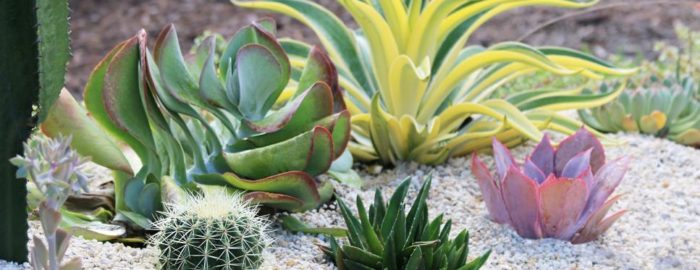Whether its Summer, Autumn, Winter or Spring, you’re bound to go on vacation at some point – but what about those beautiful houseplants?…Let me introduce you to some indoor plants you can safely leave while on vacation—without lining up a plant sitter.

Succulents and Cacti
Packing your bags and heading off on vacation doesn’t have to mean you return to a house full of dead plants. Choose the right low maintenance houseplants, and you can take off for even a few weeks without losing a single leaf. I’ve had all of these succulents shown in the image above. If anything, I’ve come back & they’ve grown! For instance, the one on the left, in the front – that stem grew & flowers bloomed.

‘Campfire’ Crassula
Keep the home fires burning with this colorful succulent. As leaves mature, they shift colors from green, to gold and orange, and finally ripen to bright red. Bright light coaxes the best leaf hues from indoor plants. The thick leaves hint that you can leave this plant for a week or two with no watering worries. The formal name for this beauty is Crassula capitella‘Campfire’.

Aloe
Just give this sturdy succulent bright light, and you’ll be on your way to a happy, healthy houseplant. Aloes need watering only every couple of weeks or so, which means you can take more than a weekend away with no worries. Well-draining soil provides the right rooting environment for this low maintenance houseplant. Come home with a sunburn from that awesome vacation?…Get relief by cutting one of your Aloe leafs off. Either cut it down the center or in half. Rub the clear “gel” from the plant onto your burn. **Be sure you’re not allergic to Aloe**

Flapjacks
Flattened paddle leaves give this succulent a playful feel and bring strong architectural interest to any setting. Indoors, give this South African native bright light, and water only when the top inch of soil is dry. Low thirst means you can skip town for a week or two with no thought for watering. Also known as dog tongue, desert cabbage and paddle plant, this plant is known botanically as Kalanchoe luciae. I have a Kalanchoe & like with many succulents a stem or leaf will fall off or break. If it’s still hardy, stick the bottom of the piece that fell off – right back into the dirt, next to the plant if you want – most of the time a new plant will grow.

Wax Plant
Known botanically as Hoya, wax plant is one of those houseplants that always makes you look good. It’s next to impossible to kill—unless you water it too much. This plant is a succulent, able to store water in its thick leaves and stems. It grows in low light, but you’ll get to see its waxy blooms in a high light setting. Feel free to leave this one for a week or more without water.

Tanzanian Zipper Plant
This cutie may resemble a cactus, but it’s actually a type of euphorbia—Euphorbia anoplia, to be exact. Euphorbias are cactus cousins known for retaining water. The thickened stems on the zipper plant hold enough water that you can slip away for a relaxing two-week trip. Give this plant bright light for best growth.

Red-Headed Irishman
Dry soil and bright light keep this cute cactus looking its best. It’s so notoriously easy to grow that it’s one of the most widely grown cacti worldwide. Expect your plant to form clumps as it ages, producing “babies” along its base. Botanically, it goes by Mammillaria spinosissima.

String of Buttons
The stems on this succulent pierce the center of each leaf, stacking them up like buttons on a string. The thick leaves hoard water, so you can get away for a relaxing two-week vacation without a second thought for this houseplant. Stems tend to trail, making this a good choice for hanging baskets. Botanically, this quirky plant goes by the name Crassula perforata. Another one would be “hens and chicks” funny name, but great succulents!

Sago Palm
You’ll be growing living history when you add sago palm to your home. The leathery leaves have a delicate, fern-like appearance that disguises the plant’s rugged personality. This beauty is a living fossil, a leftover from dinosaur times. You’ll see best growth in bright light, but it survives in low light. The easiest way to kill it is overwatering.

Glowee
Also known as snake plant, Glowee is a living nightlight. Give it a little natural sunlight each day, and you’ll be rewarded with a soft green and gold glow as night arrives. Glowee is a succulent, so it doesn’t need much water to keep it going. Keep soil on the dry side. This plant can tolerate very low interior light levels, although the glowing effect diminishes

ZZ Plant
With ZZ plant, you can take off for a year and return home to find it looking perfect. It needs that little water. The thick leaves have a natural shine, and it’s happy in any light, low to bright. The only drawback is its slow growth rate, which means it might cost a little more at the nursery (because it takes longer to grow). The double Z stands for Zamioculcas zamiifolia

Owl’s Eyes Cactus
Cactus are famous for needing little care, and owl’s eyes is no exception. Give this woolly cactus a bright, south-facing window and sharply draining cactus potting mix, and you’re good to go. Water sparingly, and keep it in a pot that’s just a bit wider than the cactus itself. It’s also goes by the name owl eye pincushion. In botanical circles, it’s called Mammillaria parkinsonii.

